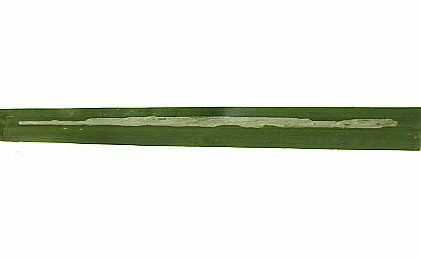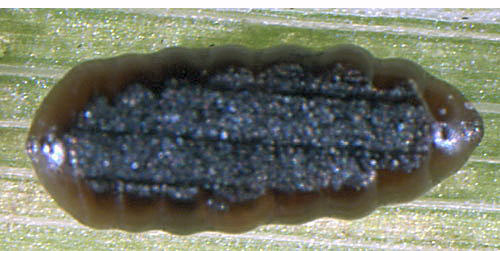|
||||||
|
SCIRPUS. Club-rushes. [Cyperaceae] |
|
Three species of Scirpus are recorded in Britain. These include the native Wood Club-rush (S. sylvaticus) and the introduced Swamp Club-rush (S. inundatus) and Knotted Club-rush (S. nodosus). Nine British miners are are recorded on Scirpus. A key to the European miners recorded on Scirpus is provided in Bladmineerders van Europa. |
Key for the identification of the known mines of British |
Note: Diptera larvae may live in a corridor mine, a corridor-blotch mine, or a blotch mine, but never in a case, a rolled or folded leaf, a tentiform mine or sandwiched between two more or less circular leaf sections in later instars. Pupation never in a cocoon. All mining Diptera larvae are leg-less maggots without a head capsule (see examples). They never have thoracic or abdominal legs. They do not have chewing mouthparts, although they do have a characteristic cephalo-pharyngeal skeleton (see examples), usually visible internally through the body wall. The larvae lie on their sides within the mine and use their pick-like mouthparts to feed on plant tissue. In some corridor miners frass may lie in two rows on alternate sides of the mine. In order to vacate the mine the fully grown larva cuts an exit slit, which is usually semi-circular (see Liriomyza huidobrensis video). The pupa is formed within the hardened last larval skin or puparium and as a result sheaths enclosing head appendages, wings and legs are not visible externally (see examples). See Key to non-Diptera. |
1a > Leaf-miner: A long yellowish green leaf-mine. Pupation external, puparium frequently adhering to leaf (Spencer, 1972b: 100; Spencer, 1976: 205). Long, rather broad corridor, about halfway along the leaf blade. Frass in a few large, black lumps. Puparium formed now in, then outside the mine. |
 Mine of Cerodontha angulata on Carex pendula Image: © Willem Ellis (Bladmineerders van Europa) |
 Cerodontha angulata puparium Image: © Willem Ellis (Bladmineerders van Europa) |
|
Cerodontha angulata (Loew, 1869) [Diptera: Agromyzidae]. |
1b > Leaf-miner: A very long mine. Pupation at base of leaf (Spencer, 1972b: 100). Puparium brown Very long upper-surface corridor, at the end about 1/3 of the width of the leaf. The mine usually begins about halfway along the blade and descends within the leaf sheath. Just before pupation all frass is deposited in one big mass. Puparium within the mine, where it also passes the winter. |
|
Cerodontha scirpi (Karl, 1926) [Diptera: Agromyzidae]. |
1c > Leaf-miner: Mines and larvae indistinguishable from C. morosa. Mine relatively short and broad, not extending into leaf base. Pupation in the mine (Spencer, 1976: 219). Upper-surface, interparenchymatous (therefore yellowish) corridor in the middle part of the leaf. The mine starts not far from the leaf tip, descends, and changes direction at least twice. Often in the end the corridor occupies the entire width of the leaf. Larva solitary. Frass in one big lump. Pupation inside the mine. The puparium is glued with frass to both the ceiling and the floor of the mine, parallel to the leaf vein. |
|
Cerodontha suturalis (Hendel, 1931) [Diptera: Agromyzidae]. |
1d > Leaf-miner: Irregular mine, locally shallow, elsewhere much deeper, giving it a mottled appearance. In broadleaved plants the mine often begins as a blotch with stellate extensions, but sometimes as a very fine, shallow corridor. In grasses the mine often begins in the leaf sheath. The frass is very fine-grained, initially scattered, later in aggregates. The egg is deposited on the plant surface, and the empty egg shell remains visible. But the larvae are able to leave their mine and restart elsewhere, thus mines without an egg shell can be found as well. The larva also leaves the mine before pupation. Pupation takes place in a newly made, small, blotch mine without frass; this mine may be made in another plant (species). |
 Mine of Hydrellia griseola on Glyceria fluitans Image: © Willem Ellis (Bladmineerders van Europa) |
|
Hydrellia griseola (Fallén, 1813) [Diptera: Ephydridae]. |
|
Key for the identification of the known mines of British |
Note: The larvae of mining Coleoptera, Hymenoptera and Lepidoptera may live in a corridor mine, a corridor-blotch mine, a blotch mine, a case, a rolled or folded leaf, a tentiform mine or sandwiched between two more or less circular leaf sections in later instars. Larva may pupate in a silk cocoon. The larva may have six legs (although they may be reduced or absent), a head capsule and chewing mouthparts with opposable mandibles (see video of a gracillarid larva feeding). Larvae of Hymenoptera and Lepidoptera usually also have abdominal legs (see examples). Frass, if present, never in two rows. Unless feeding externally from within a case the larva usually vacates the mine by chewing an exit hole. Pupa with visible head appendages, wings and legs which lie in sheaths (see examples). |
1a > Leaf-miner: Corridor, 15 cm in the end, descending from the leaf tip. The mine is whtish and shallow at first, then becomes deeper, yellowish white, and more transparant. Pupation external; pupa, not in a cocoon, attached to the leaf. |
|
Elachista albidella Nylander, 1848 [Lepidoptera: Elachistidae]. |
1b > Leaf-miner: The mine begins as a narrow corridor, somewhere halfway along the leaf; it ascends towards the tip, doubles, and descends to about the starting point. Meanwhile the corridor has widened to about half the width of the leaf. Most frass is accumulated as an elongate dark mass in the oldest part of the mine. According to Traugott-Olsen and Nielsen part of the frass can be ejected through an opening in the lowest part of the mine. The mine is greenish white and quite conspicuous. Pupation external; pupa in a loose spinning (Bland, 1996a; Traugott-Olsen and Nielsen, 1977a). |
|
Elachista scirpi Stainton, 1887 [Lepidoptera: Elachistidae]. |
1c > Leaf-miner: In autumn the larva makes a long, brown corridor, and hibernates therein. In spring a new mine is made in another leaf. This one starts near the base of the blade, widens upwards, and finally forms an elongate yellowish irregular blotch of 3-5 cm in length. According to Martini (1912a) a characteristic of this species is the extreme precision with which the mine joins up with the length venation of the leaf. Pupation external; the pupa is attached to the mine without a cocoon. |
|
Elachista serricornis (Stainton, 1854) [Lepidoptera: Elachistidae]. |
1d > Leaf-miner: The mine begins somewhere halfway the blade as an upwards running corridor. After a while the direction reverses, and an elongate blotch develops occupying half the width of the leaf. Frass, light green at first, grey later, concentrated in the lowest part of the mine. Pupation external. |
|
Elachista utonella Frey, 1856 [Lepidoptera: Elachistidae]. |
| 1e > Leaf miner / Stem-borer: Narrow gallery in a young leaf. After having mined for some time the larva becomes a borer in the stem or rhizome. The larvae feed inside the stems. |
|
Orthotelia sparganella (Thunberg, 1788) [Lepidoptera: Glyphipterigidae]. |
| Last updated 07-Jul-2019 Brian Pitkin | ||
